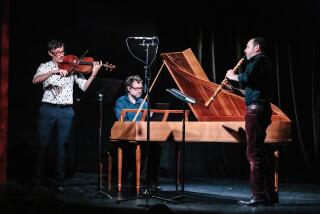No Compromises : Director of Early-Music Ensemble Would Rather Play One Era Well Than Several So-So
Tafelmusik, the early-music ensemble performing tonight at Irvine Barclay Theatre, takes its name from three volumes of music by Telemann, each incorporating a suite, concerto, chamber work and symphony. The name literally means “banquet” (or table) music, and Tafelmusik was literally intended to be served up between or during courses.
Fittingly, the music Tafelmusik generally serves up is Baroque.
“We haven’t yet officially gone beyond 1800,” said music director Jeanne Lamon, reached by phone at her home in Toronto. “We won’t until we have enough of the right players and instruments to do an excellent job. There are enough early groups in England going as far into the 19th Century as they can, who have the pioneering instinct, who want to be there first.
“We don’t seem to suffer from this malady.”
The concert, sponsored jointly by the Orange County Philharmonic Society and Laguna Chamber Music Society, marks the ensemble’s Orange County debut. The program includes Henry Purcell’s Suite from “Dioclesian”; Charles Avison’s Concerto in G after Domenico Scarlatti; Bach’s Brandenburg Concerto No. 1; Telemann’s Overture in G minor for three oboes, bassoon and strings, and Vivaldi’s Concerto in F for two horns and strings.
Though she noted that it’s always a pleasure to play music by Bach, Lamon is nevertheless most excited about performing the works by Purcell, whom she rates “right up there with Bach,” and by French composer Charles Avison.
Avison wrote 12 concertos in the 1720s based on Scarlatti harpsichord sonatas; capitalizing on the latter’s popularity, he would group four Scarlatti sonatas into a concerto grosso scheme.
“What’s interesting for scholarly types,” said Lamon, herself a scholarly type who teaches at the University of Toronto and at that city’s Royal Conservatory of Music, “is that of the 48 Scarlatti sonatas Avison used,” 10 have never been found in their original form. “It’s very unlikely that Avison would take three from Scarlatti and come up with the fourth himself.
“Someone ought to take those Avison movements and turn them back into Scarlatti harpsichord sonatas--see what Avison did and undo it.”
*
Formed in 1979 and led by violinist Lamon since 1981, Tafelmusik maintains a 40-concert season in Toronto and has toured Europe annually since 1984. Group size varies, depending on repertory, from 12 to 40; 23 members are currently touring the United States. The ensemble has made 26 albums and now records exclusively for Sony Classics.
Lamon, 43, reiterated her reluctance to jump on the historically informed Romantic era bandwagon--a bandwagon enthusiastically enjoined by such established early-music proponents as Christopher Hogwood, John Eliot Gardiner and Roger Norrington. She cited the difficulty of performing music of several periods to consistently high standards.
“There is a great deal of compromise in the rush to record,” she noted. “I want to make a version I can live with for 20 years.
“To be able to play music from 1650 to 1900, and to play everything on correct original instruments, the oboe player, for example, would need at least seven different instruments in good working order, and be making reeds for all of them. And that pretty much goes for every wind player. The violinist would need three different violins.”
The need for the various instruments is hardly academic.
“All modernizations were basically meant to make the instruments louder,” Lamon explained. “Beethoven writes a violin concerto, the violinist tries to play it on a Baroque instrument and says, ‘Mr. Beethoven, you’ve written too many wind parts.’ Beethoven insists he’s written the right number of wind parts, so the guy goes to the local violin shop, and says, ‘Do something, you’ve got to make it louder.’
“There are basic principles you follow to achieve that, but it’s tit for tat--you get a laser beam projection, you lose something of the resonance, intimacy and warmth.”
The success of Tafelmusik and other early music ensembles in a given performance, therefore, depends to a great extent on the venue, according to Lamon. She tries to book suitable halls--the Irvine Barclay seats 756--but that’s not always an easy call.
“Acoustics are more important than number of seats,” she noted. “We played the Proms at (London’s) Royal Albert Hall, which by conservative reports seats 6,000. It was full and it was fine--it’s like a huge barn, yet the acoustics were magnificent. Then you get theaters with 200 seats that are dead--and can spell death for an orchestra like ours.”
* Tafelmusik performs works by Purcell, Bach, Telemann, Charles Avison and Vivaldi tonight at 8 at the Irvine Barclay Theater, 4242 Campus Drive , UC Irvine. The concert is sponsored by the Orange County Philharmonic Society and Laguna Chamber Music Society. $12.50 to $25. (714) 553-2422.
More to Read
The biggest entertainment stories
Get our big stories about Hollywood, film, television, music, arts, culture and more right in your inbox as soon as they publish.
You may occasionally receive promotional content from the Los Angeles Times.










